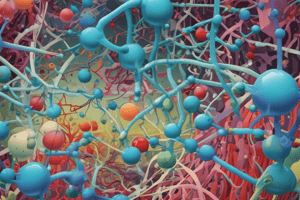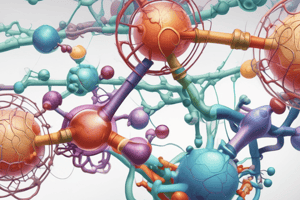Podcast
Questions and Answers
¿Qué tipo de enzimas catalizan la transferencia de grupos funcionales de una molécula a otra?
¿Qué tipo de enzimas catalizan la transferencia de grupos funcionales de una molécula a otra?
- Transferasas (correct)
- Hidrolasas
- Oxidorreductasas
- Isomerasas
¿Qué tipo de regulación enzimática implica cambios conformacionales inducidos por la unión de reguladores alostéricos?
¿Qué tipo de regulación enzimática implica cambios conformacionales inducidos por la unión de reguladores alostéricos?
- Regulación por covalente
- Regulación por represión
- Regulación por inducción
- Regulación alostérica (correct)
¿Qué enzimas catalizan la formación de enlaces C-C, C-O, C-N o C-S, requiriendo la hidrólisis de ATP o GTP?
¿Qué enzimas catalizan la formación de enlaces C-C, C-O, C-N o C-S, requiriendo la hidrólisis de ATP o GTP?
- Isomerasas
- Oxidorreductasas
- Ligasas (correct)
- Hidrolasas
¿Cómo se describe la eficiencia enzimática considerando la concentración de sustrato donde la velocidad es la mitad de la velocidad máxima?
¿Cómo se describe la eficiencia enzimática considerando la concentración de sustrato donde la velocidad es la mitad de la velocidad máxima?
¿Qué tipo de modificaciones pueden ocurrir en las enzimas de manera irreversible mediante adición o eliminación de grupos funcionales?
¿Qué tipo de modificaciones pueden ocurrir en las enzimas de manera irreversible mediante adición o eliminación de grupos funcionales?
¿Cuál es el principal enfoque de la bioquímica como rama de la biología?
¿Cuál es el principal enfoque de la bioquímica como rama de la biología?
¿Qué función desempeñan las enzimas en las reacciones bioquímicas?
¿Qué función desempeñan las enzimas en las reacciones bioquímicas?
¿Qué define la especificidad de las enzimas en su función catalítica?
¿Qué define la especificidad de las enzimas en su función catalítica?
¿Dónde se encuentran principalmente los sitios activos de las enzimas?
¿Dónde se encuentran principalmente los sitios activos de las enzimas?
¿Por qué razón las enzimas están sujetas a regulación?
¿Por qué razón las enzimas están sujetas a regulación?
Flashcards are hidden until you start studying
Study Notes
Bioquímica: Unveiling the World of Enzymology
Bioquímica, a branch of biology, focuses on the study of chemical processes that occur within living organisms. Among its subtopics, enzymology takes center stage, exploring the mechanisms, functions, and properties of enzymes. Enzymes are proteins that catalyze biochemical reactions, orchestrating the intricate dance of life that occurs at the molecular level.
Enzymes: Protein Catalysts
Enzymes are proteins that enable an array of biochemical reactions to occur at physiological conditions. They typically lower the activation energy of the reaction, thus increasing the rate at which the reaction proceeds. This is invaluable for the proper functioning of cells, tissues, and organisms. Enzymes can be found in both prokaryotic and eukaryotic organisms, and they play a critical role in metabolism, energy production, and cellular communication.
Enzyme Structure and Function
Enzymes are highly specific in their function, interacting with particular substrates to form enzyme-substrate complexes that facilitate biochemical reactions. The active sites of enzymes where substrates bind are formed by the specific amino acid sequences of the protein. Through the formation of weak non-covalent interactions, enzymes bind substrates with high affinity and catalyze the corresponding reactions.
Enzyme Regulation
Enzymes are subject to regulation to ensure that the biochemical processes they catalyze occur in optimal conditions. Regulation occurs at different levels:
- Allosteric regulation: The binding of molecules called allosteric regulators to enzymes induces conformational changes that either enhance or inhibit the enzyme's activity.
- Covalent modification: Enzymes can be irreversibly modified by the addition or removal of functional groups via phosphorylation, acetylation, or other post-translational modifications.
- Induction and repression: The synthesis of certain enzymes can be induced or repressed by the presence or absence of specific molecules in the cellular environment.
Enzyme Classification
Enzymes are classified according to the types of biochemical reactions they catalyze. The Enzyme Commission (EC) has established a systematic nomenclature for enzymes, dividing them into six major classes:
- Oxidoreductases: Enzymes that catalyze electron transfer reactions between substrates
- Transferases: Enzymes that transfer functional groups from one molecule to another
- Hydrolases: Enzymes that catalyze the hydrolysis of various bonds
- Lyases: Enzymes that catalyze the cleavage of chemical bonds other than those involving water molecules
- Isomerases: Enzymes that catalyze the interconversion of isomers
- Ligases: Enzymes that catalyze the formation of C-C, C-O, C-N, or C-S bonds, requiring the hydrolysis of ATP or GTP
Enzyme Kinetics
The study of enzyme kinetics sheds light on the rate of enzymatic reactions and the factors influencing enzyme activity. The enzyme-catalyzed reaction can be described by the Michaelis-Menten equation, which takes into account the enzyme's affinity for its substrates and the rate at which substrates are converted to products. The enzyme's efficiency is described by the Michaelis constant (Km), which is the substrate concentration at which the enzyme's velocity is half its maximum velocity (Vmax).
Conclusion
Enzymology is a crucial subdiscipline of bioquímica, providing a wealth of knowledge about the chemical processes that underpin life. The study of enzymes and their functions helps to further our understanding of the complex biochemical processes that occur within organisms, from the smallest cell to the largest multicellular organism. As a result, the progress in enzymology has the potential to impact various aspects of human life, from the development of new therapeutic agents to the efficiency of industrial bioprocesses.
Studying That Suits You
Use AI to generate personalized quizzes and flashcards to suit your learning preferences.




